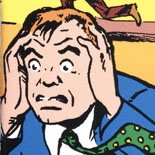I Should Let This Go
Especially since the trolls have come out to play, but one or two things caught my attention about the Heroes for Hire cover.
The first is that some people seem to forget that a comic book cover is the first, last, and best advertisement for the comic within, especially for new readers. As such, the image that appears on the cover not only communicates what happens in a given story but also why a reader would want to read it. Which is why this cover is much more objectionable than a similar image would be if it appeared only within the book. Within the book, the image would suggest that a rape, horrible and cruel, might occur. As a cover, the image communicates that raped superheroines are something attractive to see, and that the value of female superheroes is entirely their sexuality.
Secondly was something I saw in the Beat:
Heroes for Hire... these sales are little short of atrocious.God, I hope so. I hope that treating female characters as more than just sex objects and saying that women can be heroes without needing to be wank material for men is also in line with better business practices.
This raises, in passing, the controversial topic of the cover for issue #13. There seems to a common assumption, both among publishers and among their detractors, that T&A sells comics. I wonder whether that’s really true. HEROES FOR HIRE has been distinguished by prominent cheesecake art from day one, and just look at its sales. The bad girl genre is virtually dead. MIGHTY AVENGERS, with Frank Cho’s art, is doing no better than NEW AVENGERS with Leinil Francis Yu - in fact, it’s actually the lowest selling of the three Avengers titles, although not by much. And when did you ever see Greg Horn’s covers on a high-selling title?
If this sort of thing is genuinely so popular, why doesn’t it sell better? Could it be that in fact, the audience for T&A comics (or at least comics which are quite so blatant about it) is actually quite small, and that chasing them is a waste of time on commercial grounds alone?
And finally, I wanted to say kudos to Jason DeAngelis, President of Seven Seas publishing. Not specifically for canceling Nymphet per se, but for listening to the objections his fans and retailers had, re-examining the content he was planning on publishing, evaluating the audience he was planning on publishing to, and then taking full responsibility in an open letter. Things he did NOT do include deny that there was anything objectionable at all, hide behind the female creator of the sexist art, or explain that what we would find offensive in America is perfectly acceptable in Japan, as some other editor in chief did.





























